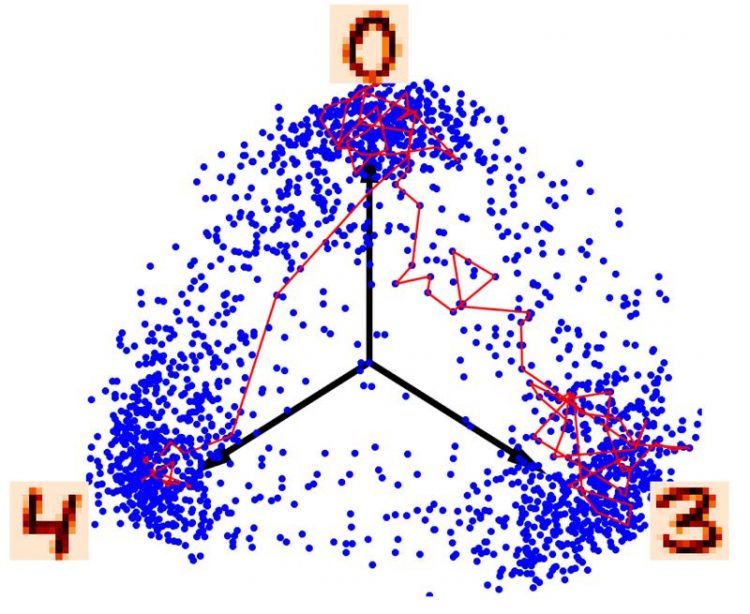When Nerve Cells Detect Patterns for Acquired Knowledge

Sampling a probability distribution of handwritten numbers by a stochastic network Mihai A. Petrovici
For observations based on sensory data, the human brain must constantly verify which “version” of reality underlies the perception. The answer is gleaned from probability distributions that are stored in the nerve cell network itself.
The neurons are able to detect patterns that reflect acquired knowledge. Applying mathematical methods, physicists from Heidelberg University and researchers from Graz University of Technology have proven this phenomenon in their investigations. The current research results, published in the journal “Physical Review”, are of major significance in developing new types of computer systems.
One of the most important functions of our brain is to create an internal model of our environment. There are two categories of information available for this purpose – the acquired knowledge about known objects and a constant stream of sensory data that can be compared against and continually added to existing knowledge. These sensory data are the simplest, “directly” available building blocks of perception.
However, observations that are based on sensory data are often compatible with multiple “realities” at the same time, as the phenomenon of optical illusions clearly proves. The brain is therefore faced with the challenge of knowing all the possible versions of the underlying reality. To make this determination, the brain jumps back and forth between these versions of reality, sampling a probability distribution.
The researchers working with Heidelberg physicist Prof. Dr Karlheinz Meier studied this process with the help of formal mathematical methods applied at the level of individual nerve cells, called neurons. The model of individual neurons used is strictly deterministic. This means that each repeated stimulation from external stimuli always evokes the same response behaviour.
The brain, however, is a network of neurons that communicate with one another. When a nerve cell is sufficiently stimulated by its neighbour, it fires off a short electrical pulse, thereby stimulating other neurons. In a large network of active neurons, nerve cells become stochastic – their “response” is no longer determined, i.e., precisely predictable, but follows statistical probability rules.
“In our studies we were able to show that such neurons obtain their response from probability distributions that are stored in the network itself and that are sampled by the nerve cells,” explains Prof. Meier. This is how neurons are able to detect patterns that reflect acquired knowledge. The research was conducted as part of the European Human Brain Project, in which the Heidelberg researchers under the direction of Karlheinz Meier are developing new computer systems using the brain as a model.
“The concept of statistical sampling of acquired probabilities is extremely well-suited for implementing a new computer architecture. It is one focus of the current research our working group is conducting,” states the physicist, who teaches and pursues research at Heidelberg University's Kirchhoff Institute for Physics.
Original publication:
M.A. Petrovici, J. Bill, I. Bytschok, J. Schemmel, and K. Meier: Stochastic inference with spiking neurons in the high-conductance state. Physical Review E 94, 042312 (published 20 October 2016), doi: 10.1103/PhysRevE.94.042312
Contact:
Dr Mihai A. Petrovici
Kirchhoff Institute for Physics
Phone +49 6221 54-9897
mpedro@kip.uni-heidelberg.de
Communications and Marketing
Press Office, phone +49 6221 54-2311
presse@rektorat.uni-heidelberg.de
Media Contact
All latest news from the category: Life Sciences and Chemistry
Articles and reports from the Life Sciences and chemistry area deal with applied and basic research into modern biology, chemistry and human medicine.
Valuable information can be found on a range of life sciences fields including bacteriology, biochemistry, bionics, bioinformatics, biophysics, biotechnology, genetics, geobotany, human biology, marine biology, microbiology, molecular biology, cellular biology, zoology, bioinorganic chemistry, microchemistry and environmental chemistry.
Newest articles

Superradiant atoms could push the boundaries of how precisely time can be measured
Superradiant atoms can help us measure time more precisely than ever. In a new study, researchers from the University of Copenhagen present a new method for measuring the time interval,…

Ion thermoelectric conversion devices for near room temperature
The electrode sheet of the thermoelectric device consists of ionic hydrogel, which is sandwiched between the electrodes to form, and the Prussian blue on the electrode undergoes a redox reaction…

Zap Energy achieves 37-million-degree temperatures in a compact device
New publication reports record electron temperatures for a small-scale, sheared-flow-stabilized Z-pinch fusion device. In the nine decades since humans first produced fusion reactions, only a few fusion technologies have demonstrated…





















